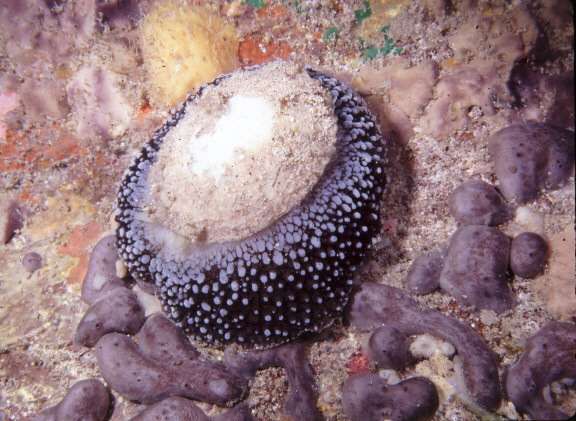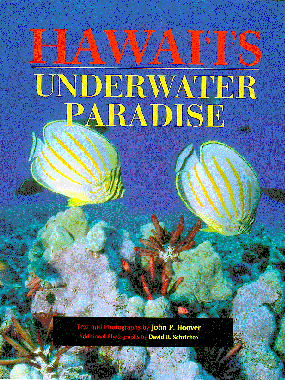
| Umbraculum umbraculum Halona Blowhole, O`ahu. 15 ft. Courtesy of John Hoover 1997 |
Umbraculum umbraculum
UMBRELLA SLUG * `opihi kapua`i lio
Umbraculum umbraculum Lightfoot, 1786
Order Notaspidea; Family Umbraculidae
One of the oddest of all opisthobranch molluscs, this large sponge-eating slug is topped by a calcareous disk too small to cover the complete animal. Even its naked gills are barely protected. The body (black, brown, yellow or orange), is covered with white warts and pustules. Two eyes and a nose-like penis sometimes form the rough semblance of a face The slug occurs in a variety of habitats from caves and crevices in exposed reefs to sheltered reef flats. The white or red egg coils attain the same diameter as the slug. The sole species in its genus, it has a wide Indo-Pacific and tropical Atlantic distribution. Uncommon in Hawai`i. To about 3 inches across
Photo and Text courtesy of John Hoover

I suspected they might be umbrella slugs. I had read about these bizarre animals and in fact had been looking for them for years. I badly needed a photo for my upcoming book on Hawaii's marine invertebrates. The following Sunday Ron and I drove out to Oahu's Halona Blowhole where the cave was located. Luckily, the sea was calmer than usual on the the southeast side of the island that day. I knew that cave, and under normal wave conditions, I wouldn't have wanted to get anywhere near it. Situated at one end of a shallow underwater ravine, its huge funnel catches the surge and channels it upward through tortuous crevices until, under tremendous pressure, water jets out from the cliffs above in a fountain of spray. Underwater, air compresses in the recesses of the cave and explodes back, causing shock waves--deep, powerful thuds that resonate in your chest. It feels like your heart is skipping beats and your depth gauge goes wild. On the walls of this spooky cave grow meandering multicolored sponge formations--perfect slug territory. Entering the water off the tiny beach (made famous in the movie "From Here to Eternity"), we swam out a short distance and submerged. The cave entrance was only 5 minutes away at a depth of about 15 feet. Cautiously we entered and sure enough, high up on the wall of the left side were two umbrella slugs grazing on the sponges. Near the largest (about 3 inches across) was a white egg coil the same diameter as the animal. Swaying back and forth in the surge, trying to ignore the heart-stopping thuds I snapped picture after picture from every angle and at every exposure until Ron signaled that we had better get out while the going was good. This cave was not a good place to be if a large rogue wave came through. The rest of the dive was uneventful, but it's still a dive I'll not soon forget. Thanks, Ron!
|
Hawaii's Fishes, a Guide for Snorkelers, Divers and Aquarists Mutual Publishing, 1993
Hawaii's Underwater Paradise, Mutual Publishing, 1997
Send John E-Mail at hoover@hml.org
© The Slug Site, Michael D. Miller 1998. All Rights Reserved.
